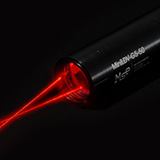| about | products | solutions | publications | contact | |
|
LDV/LDA microS microV miniPCS |
|
how an LDV/LDA works |
 |
Frequency Shifting and the Determination of DirectionWhen two beams are crossed in space as in a classical LDV/LDA, the interference pattern is steady with space. This means that 1) it is impossible to know if the particle was traveling from left to right or right to left, and 2) it is impossible to measure very low velocities, because it will take too long for the particle to travel through a bright and dark region (alternatively, the beat frequency is too low). The trick is to add a Doppler shift to the beams themselves. When an LDV has "frequency shifting", the beams already have a frequency difference when they are in space, so if a particle has velocity zero, the recorded signal will have the same frequency as the difference in frequency between the two beams. The effective frequency of the signal is the sum of the frequency due to the particle and the shift frequency. So when a particle is going one way, it will add to the shift frequency; going the other way it will subtract—and if it has velocity zero it does not change the shift frequency at all. Viewed another way, the fringes are moving in space, so the actual measurement is the velocity of the particle relative to the velocity of the fringes. MSE's miniLDV can be ordered with or without frequency shifting. For ultra-stable frequency shifting applications (to measure extremely low velocities), MSE offers the ultraLDV line. It should be noted that any LDV or LDA measures only the component of velocity along the direction of the interference pattern—so the instrument must be aligned to the flow (or some known direction so that adjustments to the results can be made). MSE also offers multi-component systems: the 2D miniLDV and 3D miniLDV. |